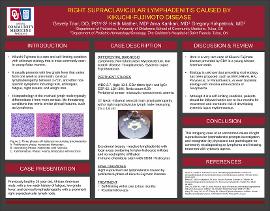| dc.description.abstract | INTRODUCTION: Kikuchi-Fujimoto disease is a rare and self-limiting condition with unknown etiology that is most commonly seen in young Asian women. It usually presents with low grade fever that varies from one week to one month, cervical lymphadenopathy between 2-7cm, and other non-specific symptoms including rash, arthralgias, fatigue, night sweats, and weight loss. Histopathology of the involved lymph node typically differentiates it from more serious, life-threatening conditions that mimic similar clinical features, such as lymphoma.
CASE DESCRIPTION: We present the case of a previously healthy 15-year-old, African-American male, with a two week history of fatigue, low grade fever, and cervical lymphadenopathy with a prominent right supraclavicular lymph node. Lab work was significant for leukopenia, anemia of chronic disease, and mildly elevated ESR and LDH. Monospot testing was initially negative; however, EBV titers (both IgM and IgG) were found to be elevated. CT scan of the neck was consistent with bilateral cervical chain lymphadenopathy with a right supraclavicular lymph node measuring 2.5 x 1.6cm. Peripheral smear was negative for blasts and immunotyping by flow cytometry was negative for lymphoid population. Supraclavicular lymph node excisional biopsy showed focal areas containing lympho-histiocytic infiltrate and immunochemistry stain with CD68 of the lymph node was positive for histiocytes, consistent with proliferative phase of Kikuchi-Fujimoto lymphadenitis.
DISCUSSION: Here is a very rare case of Kikuchi-Fujimoto disease preceded by EBV in a young African-American male. Etiology is unknown but preceding viral etiology has been proposed, such as EBV, HHV-6, HIV, Parvovirus, or Parainfluenza, or even bacterial etiology with Yersinia enterocolitica or Toxoplasma. Although it is a self-limiting condition, patients should be followed within one to four months for recurrence and increased risk of developing systemic lupus erythematosus. This intriguing case of an uncommon cause of right supraclavicular lymphadenitis prompts investigation and recognition by physicians and pathologists to avoid misdiagnosing it as lymphoma and initiating treatment with cytotoxic agents. | en_US |

